Tiruchendur – Awaiting Soorapadman’s Inevitable Fall
Soorapadman, a powerful Asura, was the son of Sage Kashyap and Maya, a sorceress of the Asura clan. Soorapadman’s mother had already taught her son many magical tricks and the use of powerful enchanted weapons. Further, the ambitious Asura meditated for many years on Lord Brahma and Lord Shiva, receiving powerful boons that made him almost invincible.

The more powerful he became, the more vain and arrogant he grew. And he was not alone in his endeavours to harass the devas and the humans of the world. He was helped by his two younger brothers, Tarakasura and Simhamukha. The primary purpose of Skanda’s birth was to end the terror these three brothers inflicted.
Simhamukha had seen the young Muruga tear apart the mighty Tarakasura. And he realised he had been born of divine power, and that fighting him was useless. He tried explaining this to Soorapadman, who was blind to everything except his egoistic desire to exact revenge for the death of his brother, Tarakasura.
“My dear Anna, I have seen Muruga fight like a seasoned warrior. He was not an ordinary child when he killed our brother. You have got enough revenge through the harassment of the devas and devotees on earth. Give up your desire to kill Skanda, especially now, since he has grown into a young, handsome god controlling the entire Gana army of Shiva. He was invincible as a young, and he is bound to be even better as a young deva. And don’t forget, he is the son of Shiva and Shakti, the invincible combination of male and female power,” Simhamukha tried to reason with Soorapadman.
“What do you need to prove to anyone, Anna?” Simhamukha continued his pleas. “Shouldn’t you think of your loving, Padmakomalai, and your sons. Banukopan, your eldest idolises you. Shouldn’t you teach him the ways of peace and forgiveness, too? Strategy and a balanced approach will help you become a wiser ruler than relentless wars and battles.”
But Soorapadman was beyond redemption, beyond help.
He retorted to his younger brother angrily, “Don’t you want to kill the one responsible for your brother’s death. You may be crippled by fear. I’m not. Remember, I have also defeated the entire Deva Army —and that, too, so badly that Indra ran away, nursing his bruised ego in Siyali. I hear he is spending his time on prayer and meditation.”
Soorapadman’s mocking laughter rang through his court even as some of his sycophantic courtiers and followers joined in. His ego had taken over control of his faculties, which was a clear sign that his end was near.
“And don’t worry about my family. I have taught my sons to be great warriors, and they will help me avenge my brother. You are duty-bound to help me defeat Skanda, our brother’s killer.”
Simhamukha, the one with the face of a lion, left the court, dejected that he couldn’t convince his eldest brother to step back, to live contentedly and happily. He knew he was obliged to fight with his brother, and his sadness deepened when he realised that he too, like his two brothers, Soorapadman and Tarakasura, would be killed ignominiously.
Suddenly, he realised he could do something after finishing his familial obligation to Soorapadman. He felt more at peace once he resolved on his final act.
Skanda – Senthilnathan – the Lord of Victory in Tiruchendur
The battle between Muruga and Soorapadman lasted six bloody days. Although Soorapadman’s death was inevitable, and he knew it, he didn’t give up until his last breath. Fighting was his mettle and his life purpose, and he did so without rancour.

As the six days rolled on, the might of Soorapadman reduced considerably, and by the end of the sixth day, his army lay scattered and thoroughly defeated. He stood with his brother Simhamukha in front of Skanda, who was ready to fire his powerful Vel —his mother Parvati’s gift to him —at the two Asura brothers.
Knowing his obligation to his brother was fulfilled, Simhamukha fell at Muruga’s feet and sought salvation and forgiveness, who happily liberated him, making the repentant Asura a lioness —a powerful vaahan for Durga, one of the powerful forms of his mother, Parvati.
Now, Soorapadman faced Skanda, almost defeated but refusing to surrender, like a warrior. The fight was bloody and brutal. Finally, when the Asura realised that there wasn’t even a slim chance of his victory, he transformed into a gigantic tree and affixed himself in the middle of the ocean, far away from the shore.
Muruga lifted his Vel, the indomitable spear gifted by his mother, and threw it at the tree, splitting it into two halves. Before his death, Soorapadman realised the folly of his arrogant and brutal ways and sought forgiveness from his divine vanquisher.
Accepting his humble death wish, Skanda granted the Asura the boon of becoming a permanent fixture in his life. One half of the tree became a rooster, the emblem of Senthilnathan, found on his flag. The other half became a peacock, Muruga’s vaahan.
Author’s Note:
Tiruchendur is one of the six temples of Muruga, collectively referred to as Aarupadaiveedu. The story of Soorapadman is recorded in the Skanda Purana, and the Tamil version, the Kandha Puranam, provides it in much more detail.
The earliest known work recording the stories of Aarupadai Veedu is believed to be Thirumurugaatrupadai by the legendary poet Nakkeerar (also called Nakkeeranar), dating to between 1 CE and 3 CE, during the Sangam Era and/or the post-Sangam Era.
The temple of Tiruchendur is dedicated to the victory (Senthil in Tamil) of Muruga over Soorapadman, and Skanda is referred to as Senthilnathan, the Lord of Victory. The six days during which the battle between Soorapadman and Senthilnathan took place are celebrated every year in Tamil Nadu as Skanda Sashti.
The other meanings of Senthil are red, formidable, and beautiful, all of which fit the description of Muruga. Also, Tiruchendur is named after the word Chendur, which means red, and Thiru is a term of respect commonly used in Tamil.
Here are more stories from our puranas and itihasas – Samudra Manthan – The Churning of the Ocean
This blog post is part of ‘Blogaberry Dazzle’
hosted by Cindy D’Silva and Noor Anand Chawla
in collaboration with Ratna Prabha.

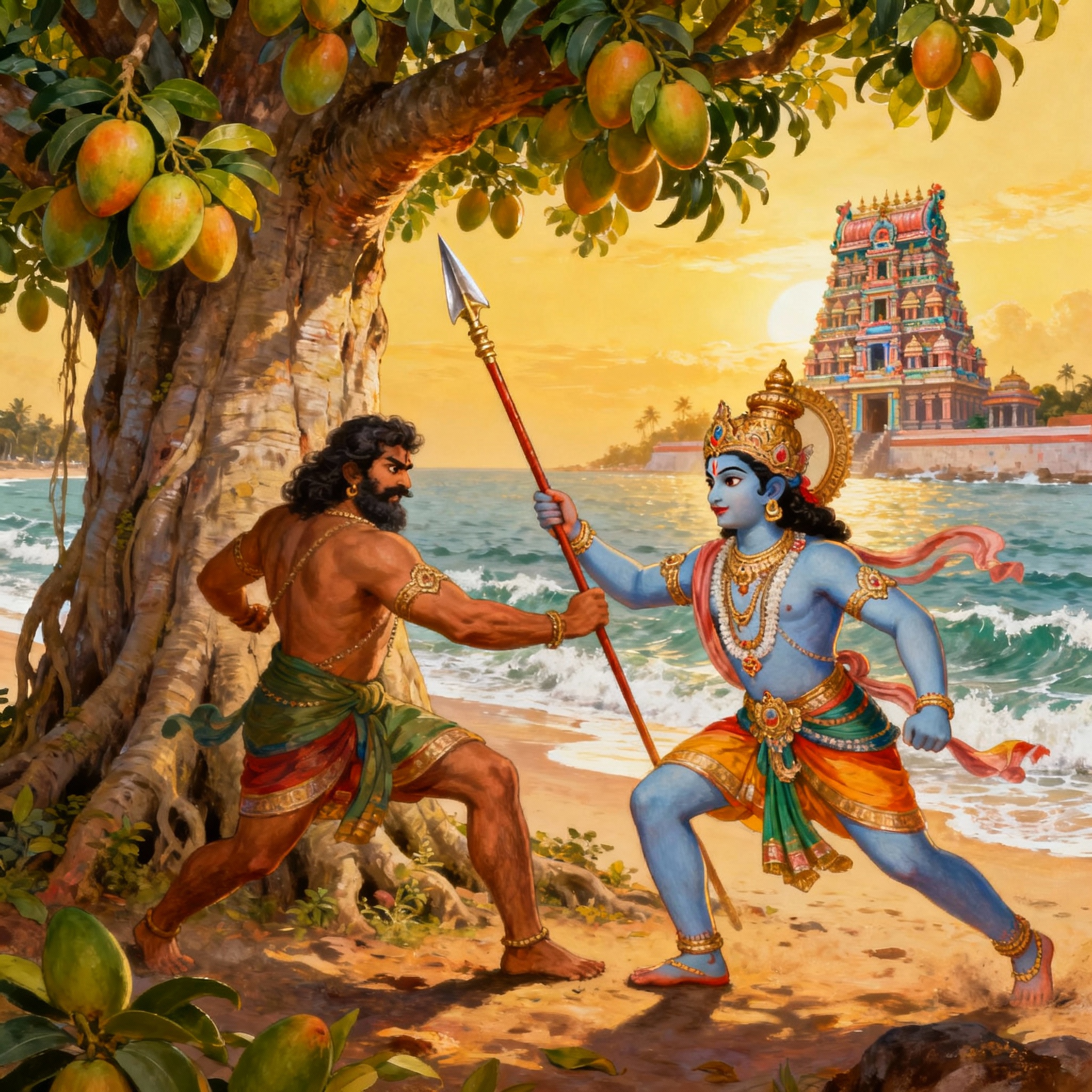
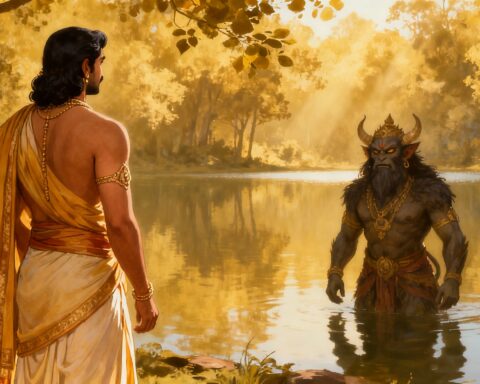
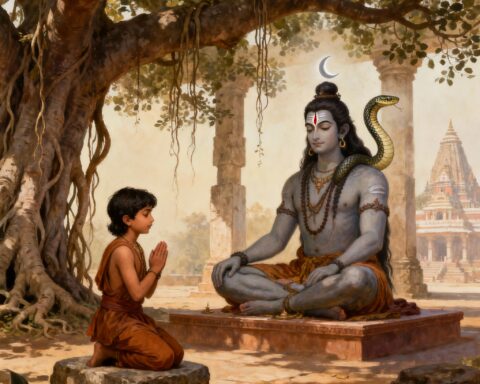
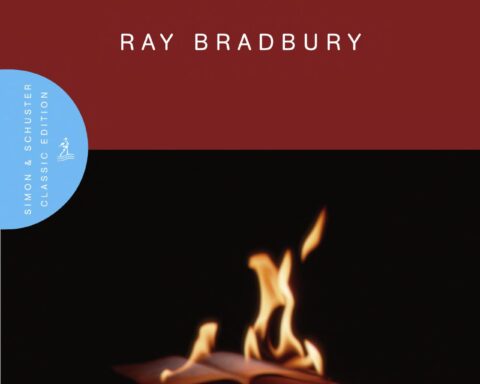

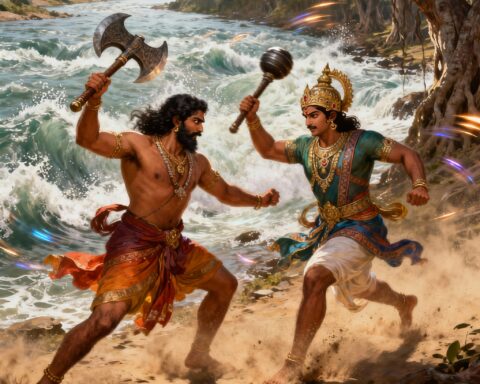
Your tales are a learning for me every time. I have not heard or read this story before. How vast our mythology is and never-ending.
Really enjoyed how you brought out the story of Tiruchendur and the myth of Soorapadman in such an engaging way
Keeping your readers engaged till the end is an art and you mastered that so well. You weaved the story known to many of us in a unqiue and impactful way which makes me read it in a new way. Tiruchendur and Soorapadman – Both the characters looks so new to me from your presentation.
I’ve never read thus story. It was good to know about this temple and the mythical tale was interesting.
Lovely piece. I didn’t know much about Tiruchendur’s story of Soorapadman, and your writing brought the place alive. The mix of myth, sea breeze and temple rhythms sounds like a real hidden gem. Adding it to my Indian-coast road-trip list.
Your description of the temple as “the place of Soorapadman’s fall” gave the myth a physical, almost cinematic space.
Such an engaging narration.. Love how you described the story of Tiruchendur and the myth of Soorapadman. Always love reading your blogs. Thank you so much!
This is a new story to me. But so much to learn from. Really stories and learnings made simple.
Thanks to your blog, I am reading this story for the first time. There are so many such tales that we haven’t even heard of but writers like you uncover them and bring them to us through such vivid storytelling and keep them alive in our heart and soul. Thank you!
I remember watching a beautiful dance recital in margazhi utsavam. To think it is close to a year since we enjoyed all in Chennai. Your post was as enthralling as the dance drama.
This was an interesting story. Never heard of it before. So many beautiful nuggets to learn from our puranas.
I absolutely loved the retelling and it s a great experience to watch soora samharam